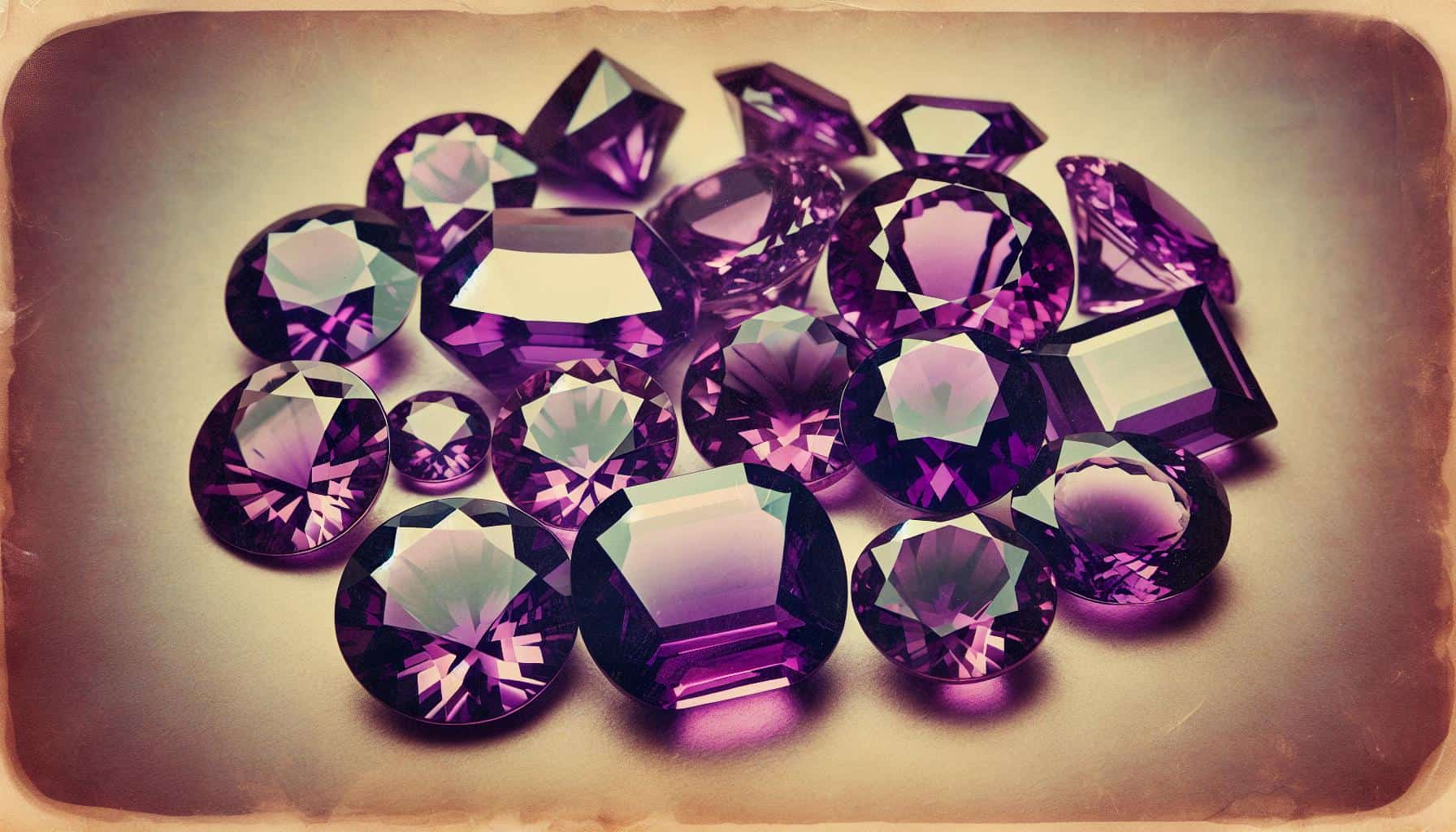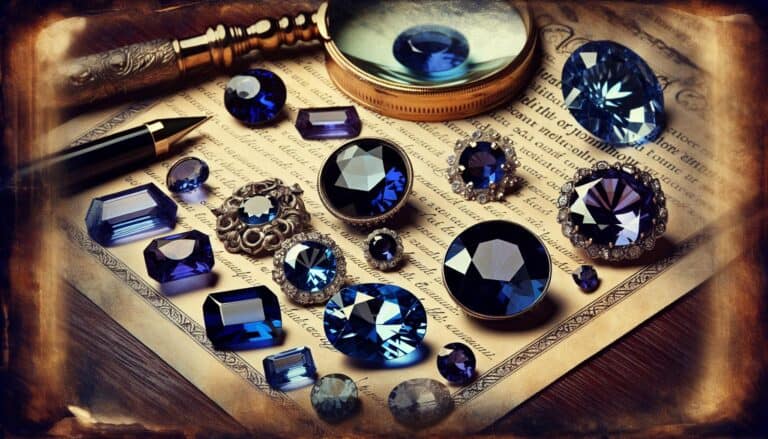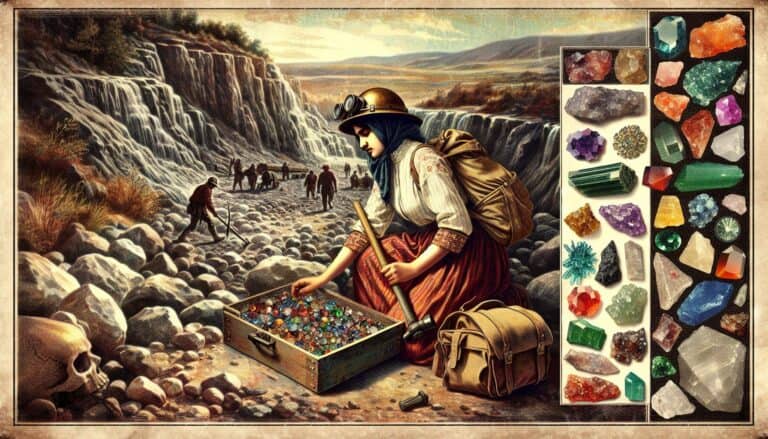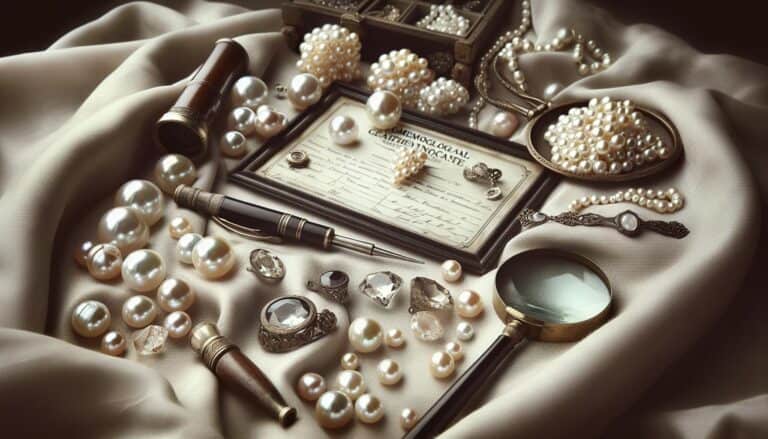Ever wondered how much your amethyst gemstone is worth?
It’s a question that crosses the mind of anyone who’s ever been captivated by its mesmerizing hues. Amethyst, with its striking purple color, can vary greatly in value depending on several key factors.
From deep violets to soft lilacs, amethysts are not only beautiful but also relatively affordable. You might be surprised to learn that despite its royal look, amethyst is considered a semi-precious stone. But don’t let that term fool you; the worth of amethyst can still be quite significant.
Understanding the worth of amethyst involves more than just admiring its beauty. It’s about recognizing the nuances that impact its market value.
Let’s unravel the mystery behind the valuation of this popular quartz variety, ensuring you’re well-informed whether you’re buying, selling, or simply appreciating.
The value of amethyst hinges on color, clarity, cut quality, and rarity. Top-quality amethysts are deep purple with red flashes. Rarity is influenced by geological origins, with Siberian amethyst being most prized. Market demand and availability also affect pricing, with unique characteristics like inclusions sometimes enhancing value.
What Is Amethyst?
Amethyst, a type of quartz, is renowned for its captivating purple hue. It’s a gem that you’ll often find in jewelry, from simple pendants to elaborate high-end pieces. Mining locations for amethyst span the globe, with Brazil and Uruguay known for large and high-quality deposits. However, it’s not just limited to these countries; you can find this gem worldwide, contributing to its accessibility and popularity.
In terms of hardness, amethyst scores a 7 on the Mohs scale, indicating good durability for daily wear. This fact alone makes it an appealing choice for jewelry that’s both striking and resilient. That resilience also means it maintains its polish well, catching the eye with its glass-like luster.
Apart from its physical properties, amethyst boasts a storied past. Known as the ‘stone of sobriety,’ it was believed by ancient Greeks to prevent intoxication. This gem also carries a spiritual heft, often associated with calmness and clarity—traits that continue to endear it to those seeking a stone with more than just aesthetic value.
As you explore the worth of amethyst, you’ll discover that color plays a pivotal role. The most sought-after shade is a deep purple with red flashes, known as “Siberian” hue, while lighter lilac shades are considered less valuable. The gem’s saturation and the consistency of its color distribution significantly affect its market value.
Clarity is another major factor, with inclusions detracting from the gemstone’s worth. However, inclusions unique to amethyst, such as tiger-stripe or chevron patterns, can enhance its appeal to collectors who value rarity and natural quirks.
Remember, the overall worth of amethyst is not just in its physical appearance but also its history, rarity, and place in culture and lore. As you consider adding amethyst to your collection or selecting it for a piece of jewelry, these aspects all intertwine to determine its true value within the market.
Amethyst Prices: Factors That Affect Value
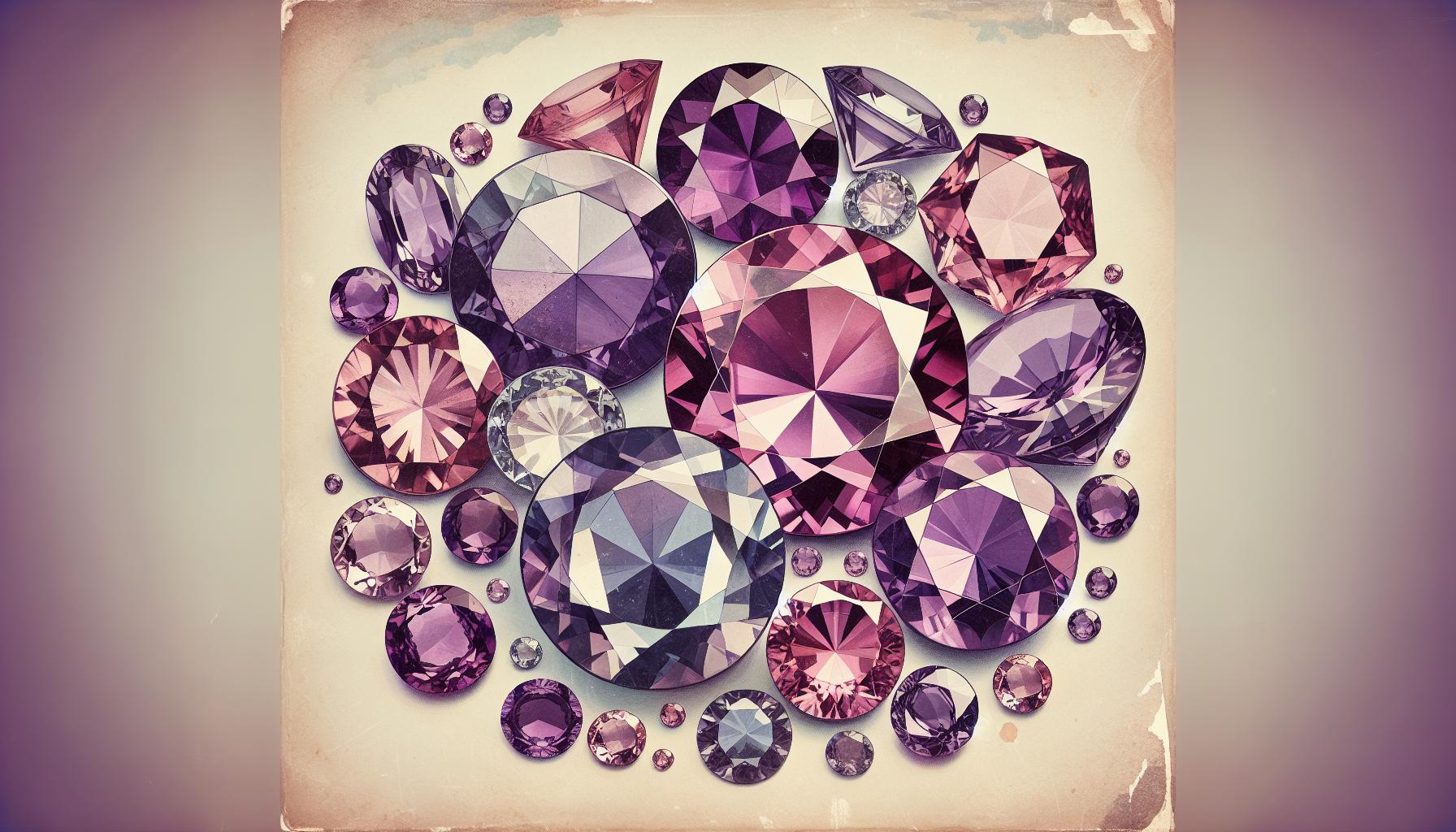
Color, Clarity, and Cut Quality
When you’re looking to determine the value of an amethyst, it’s crucial to consider its color, clarity, and cut quality. These aspects are paramount in the gemstone’s overall appeal and market value.
- Color is the most noticeable attribute and plays a significant role. Amethysts range from light lavender to deep purple, and the most sought-after stones exhibit a deep purple color with reddish hues, often referred to as “Siberian” deep purple. It’s these rich, vibrant colors that fetch higher prices.
- Clarity refers to the number of inclusions or imperfections in the stone. Like diamonds, amethysts with fewer inclusions are more valuable. High clarity amethysts are transparent, allowing light to pass through unimpeded, which enhances the stone’s luster.
- Cut quality can’t be overlooked as it impacts the stone’s brilliance. Masterfully cut amethysts showcase the gem’s beauty to its full potential, reflecting light to create a brighter, more appealing stone.
These characteristics significantly influence an amethyst’s value, so it’s worth paying attention to them when you’re assessing a piece. A stone that’s well-balanced in color, clarity, and cut quality is likely to be valued higher than one that lacks in any of these areas.
Market Demand and Availability
The forces of market demand and availability also steer the value of amethysts. These factors can fluctuate based on a variety of circumstances, making the worth of an amethyst quite dynamic.
- Market Demand: Jewelry trends and consumer interest often dictate market demand. If there’s a surge in the popularity of purple gemstones, expect amethyst prices to rise.
- Availability: While amethyst is relatively abundant compared to rarer gemstones, high-quality examples are less common and command higher prices. Regions known for premium amethysts, like Brazil and Uruguay, can influence international pricing, especially when they produce stones with exceptional color and clarity.
Keep in mind, with new deposits being discovered and market trends shifting, the value of amethyst can be subject to change. Paying close attention to market reports and gemstone auctions can provide insight into the current demand and the impact on amethyst prices, giving you a better understanding of what to expect when buying or selling these alluring purple stones.
Understanding Amethyst: A Rare Gem

The Rarity of Amethyst
Even though amethyst is a relatively common quartz, its finest quality pieces are rare and sought after. It’s important to know that amethyst’s rarity is directly tied to its color and quality. The most prized stones are those with the deepest and most vivid purple hues, and these are not as plentiful as the paler or more muted colors common in the market. The presence of iron within the quartz crystal structure contributes to the rich coloration that sets the highest quality stones apart. However, amethyst has a unique point of rarity; it’s often found in geodes of impressive sizes, which allows for the creation of large and dramatic gemstones.
Historically, amethyst was as expensive as ruby and emerald, making it one of the cardinal gemstones. However, large deposits discovered in Brazil and other locations in the 19th century changed its status. Now, it is more accessible, yet top-grade amethyst retains its value due to its rarity and desirability.
Origins and Characteristics
Amethyst is primarily mined in Brazil, Uruguay, and Madagascar, with Brazil being the largest producer of amethyst gems. When you’re evaluating amethyst’s value, it’s crucial to take into account its origins and inherent characteristics. Each mine produces amethyst with distinguishing features. For instance, amethyst from the mines of Brazil is renowned for its large size and ample availability, whereas Uruguayan amethyst typically boasts a deeper color, often sought by collectors and enthusiasts.
Here are key characteristics that contribute to an amethyst’s value:
- Color
- Range: Pale lilac to deep purple
- Highest Value: Deep purple with red or blue secondary hues
- Clarity
- Eye-clean stones, without visible inclusions are more valuable
- Included stones are less pricey and common
- Cut
- Should maximize the stone’s color and minimize color zoning
- Poorly cut amethyst can appear washed out or uneven in color
Amethysts possess unique qualities like pleochroism, which means they showcase different colors from different angles. This can include hues of red and blue, contributing to the stone’s allure. In addition, amethyst has a rating of 7 on the Mohs scale of hardness, making it relatively durable for daily wear, and thus, a popular choice for jewelry. The gem’s characteristics, along with its origin, often aid collectors and jewelers in pinpointing its desirability and potential market price.
Amethyst Grading and Valuation
The Grading System for Amethyst
When you’re out there hunting for the perfect piece of amethyst, knowing the grading system can be your secret weapon. Unlike diamonds which follow the strict and globally accepted 4Cs guideline, amethysts don’t have a standardized grading scale. However, experts generally evaluate them based on color, clarity, cut, and carat weight, borrowing from the diamond grading system.
Color is often the deal-maker or breaker. Top-tier amethysts flaunt a deeply saturated purple, ideally with flashes of red or blue without any brownish or dull hues. The clarity of the stone shoots up its value; eye-clean specimens, which means no inclusions visible to the naked eye, are most sought after. The cut of the amethyst is crucial too—it should maximize the stone’s color and minimize any visible zoning. Lastly, the carat weight impacts value; larger stones can command higher prices but remember, size doesn’t trump quality.
Certification and Appraisal
Your amethyst might tick all the right boxes on the grading system, but without a reliable certification, it’s like a crown without its jewel—valuable yet not fully recognized. Certification from esteemed labs like the Gemological Institute of America (GIA) or the American Gem Society (AGS) ensures that your gem’s qualities are meticulously assessed and documented.
In situations where certification might not be available or necessary, a professional appraisal can be handy, especially for insurance purposes or resale. An experienced appraiser will examine your gemstone and determine its market value considering its grading, rarity, and market demand. They’ll also take into account historical and cultural relevancy, which can sometimes result in premiums for the stone. Whether for an heirloom or your latest acquisition, an appraisal can provide both peace of mind and economic assurance.
Ready to get your amethyst graded or appraised? Here’s what you need to know:
- Look for appraisers affiliated with reputable organizations like the National Association of Jewelry Appraisers (NAJA) or the International Society of Appraisers (ISA).
- Transparent documentation should detail every aspect of your stone, including its measurements, treatments (if any), and quality grade.
Remember, while the beauty of amethyst often lies in the eye of the beholder, its value is greatly influenced by its measurable attributes. Understanding the grading and having the right paperwork solidify the worth of your purple treasure.
Current Market Trends in Amethyst Pricing
Navigating the complex world of amethyst pricing, current market trends play a pivotal role in understanding how much your gemstone might be worth. As with many gems, prices can fluctuate based on multiple factors, including market demand, global economic conditions, and the availability of high-caliber stones.
A recent surge in popularity for colored gemstones has seen an uptick in amethyst prices. Top-quality stones with the coveted deep purple color, known as “Siberian” amethysts despite their origin, often fetch higher prices on the market. These are sought after for their beauty and vibrancy and are considered a staple in fine jewelry pieces.
Market Accessibility and increased mining in countries like Brazil have made lower-quality amethysts very affordable. These types of gems are more common and may sell for just a few dollars per carat, making them popular for costume jewelry and lower-priced market segments.
Interestingly, the allure of amethyst has expanded beyond jewelry into home decor. Large amethyst geodes and clusters have become designer favorites for adding a natural yet luxurious touch to interiors. Their price, while dependent on size and quality, can range from hundreds to thousands of dollars, reflecting a robust market for amethyst specimens.
| Quality | Price Range Per Carat |
|---|---|
| Commercial Quality | $2 – $10 |
| Good Quality | $15 – $40 |
| Top-Quality (Siberian) | $50 and above |
Keep in mind, prices for amethyst are also influenced by the uniqueness of the stone’s features. Characteristics such as the presence of citrine zones, known as ametrine, or rare red flashes within the purple, make certain amethysts more unique and can lead to a premium in pricing.
In the current market, buyers and collectors remain keen on acquiring amethysts that offer that perfect balance of deep color, clarity, and expert cut. Whether you’re looking to buy or sell, staying informed on these market trends is crucial in making educated decisions when it comes to valuing amethyst gems.
The Most Expensive Amethyst
When you’re delving into the world of precious stones, it’s fascinating to uncover what makes some stand out above the rest. In the sphere of amethysts, the most expensive pieces are those that display exceptional traits. Such gems boast an alluring deep purple color, often referred to as “Royal Purple”, which is the pinnacle representation of high-quality amethyst.
These luxurious amethysts reflect a striking balance of color saturation and clarity, ensuring that light passes through them, creating a mesmerizing glow. It’s this combination that can elevate their value significantly. Often sourced from the remote mines in Russia or Zambia, these top-tier amethysts are renowned for their rarity and unrivaled beauty.
Not only is the color important but so is the size of the gemstone. The larger the amethyst, particularly when it maintains high color quality and clarity, the more it’s considered a collector’s item, attracting hefty price tags. Collector-grade amethysts can be substantially more valuable, often fetching thousands of dollars per carat.
| Quality | Price Range per Carat |
|---|---|
| Commercial-grade | $2 – $15 |
| Good to high-quality | $15 – $40 |
| Top-quality | Above $40 |
| Collector-grade | $100 – several $1000 |
You’ll find that these elite amethysts often grace the collections of connoisseurs or are the centerpiece of high-end jewelry pieces. Their price can soar even higher if they’re part of an antique piece or have a noteworthy provenance that connects them to historical figures or events.
Keep in mind, when shopping for these gems, it’s vital to consider the source. Renowned locations like the Ural Mountains in Russia and artisanal miners in Zambia might offer certificates of authenticity, which can reassure you of the gem’s value. With ever-changing market demands and tastes in luxury goods, the most expensive amethysts continue to captivate enthusiasts and investors alike.
Buying Amethyst: Tips and Recommendations
Where to Purchase High-Quality Amethyst
When you’re looking to buy high-quality amethyst, it’s crucial to choose reputable dealers. Specialist gemstone stores often carry a range of amethysts, allowing you to inspect the quality directly. Additionally, jewelry trade shows are excellent places to find a variety of amethysts. At these events, you can often deal directly with the miners or wholesalers.
Online marketplaces have also become popular platforms for purchasing gemstones. Websites like eBay and Etsy allow you to browse a vast selection from different sellers. However, when buying online, pay attention to the seller’s ratings and customer reviews. High-resolution images and detailed product descriptions are signs of a credible seller. Remember to inquire about the return policy in case the stone doesn’t meet your expectations upon arrival.
Ensuring Authenticity and Value
To ensure you’re getting an authentic high-quality amethyst, always ask for a certificate of authenticity. This document should come from a recognized gemological laboratory and will confirm the gemstone’s natural origin. It will also provide valuable information about the stone’s characteristics like its cut, color, clarity, and carat weight.
Here are some key points to consider:
- Certification: Look for certifications from reputable organizations such as the Gemological Institute of America (GIA) or the American Gem Society (AGS).
- Seller’s Credentials: Research the seller’s background and experience. Established sellers with expertise in gemstones are more likely to provide quality items.
- Inspection Period: Verify if there’s an inspection period during which you can return the stone without any cost if it doesn’t match the description or if you’re dissatisfied with its quality.
It’s also a smart move to familiarize yourself with the market prices of amethysts. Comparing prices among different sellers can help you understand the standard rates for different grades of stones. Remember, the most expensive amethyst will have a deep purple hue with no visible color zoning.
Prioritizing these aspects will tremendously enhance your chances of acquiring an amethyst that isn’t just visually appealing but also a worthwhile investment. Your understanding of a gemstone’s provenance, combined with prudent shopping practices, can result in a fulfilling purchase that meets both your aesthetic and financial expectations.
Conclusion: Buying & Selling Amethyst
Understanding the worth of amethyst hinges on recognizing its unique qualities and the factors that influence its value.
Whether you’re drawn to its vibrant purple shades or its historical significance, it’s clear that high-quality amethysts are a prized possession. Remember, the deeper the color and the more flawless the cut and clarity, the more valuable the gemstone. As you venture out to select your own amethyst, keep in mind the insights on authenticity and the importance of buying from reputable sources.
With the right knowledge, you’ll find a gem that’s not only beautiful but also a worthy investment.

